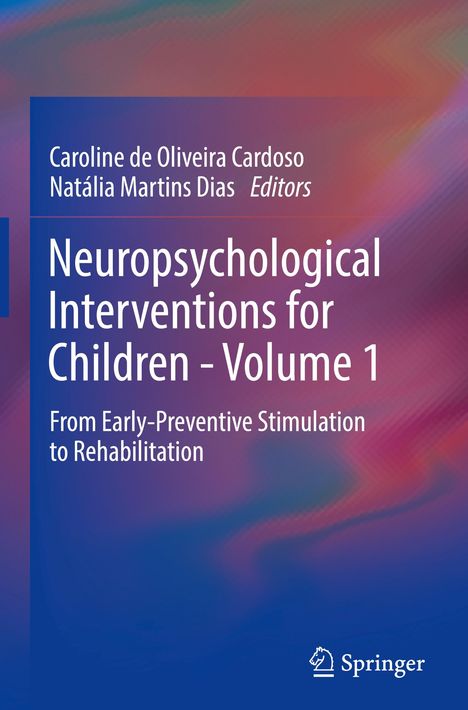Neuropsychological Interventions for Children - Volume 1, Gebunden
Neuropsychological Interventions for Children - Volume 1
Buch
- From Early-Preventive Stimulation to Rehabilitation
lieferbar innerhalb 2-3 Wochen
(soweit verfügbar beim Lieferanten)
(soweit verfügbar beim Lieferanten)
Aktueller Preis: EUR 117,33
- Herausgeber:
- Natália Martins Dias, Caroline de Oliveira Cardoso
- Verlag:
- Springer Nature Switzerland, 04/2024
- Einband:
- Gebunden, HC runder Rücken kaschiert
- Sprache:
- Englisch
- ISBN-13:
- 9783031535857
- Artikelnummer:
- 11818496
- Umfang:
- 212 Seiten
- Nummer der Auflage:
- 2024
- Ausgabe:
- 2024
- Gewicht:
- 489 g
- Maße:
- 241 x 160 mm
- Stärke:
- 18 mm
- Erscheinungstermin:
- 5.4.2024
- Hinweis
-
Achtung: Artikel ist nicht in deutscher Sprache!
Klappentext
This book is the first of two volumes that aim to serve as a comprehensive guide for professionals working with neuropsychological interventions especially designed for children. This first volume presents the theoretical foundations, tips and guidelines for neuropsychologists to develop different interventions, such as stimulation and early intervention with a focus on promoting neuropsychological health; habilitation, appropriate for work with neurodevelopment disorders; and rehabilitation, in cases of structural alterations. In this sense, it reflects the editors' concern to provide material with practical tips, but theoretically grounded, and truly useful to professionals in clinical and also school contexts.This first volume is divided into two parts. The first addresses the theoretical and practical foundations of child neuropsychological assessment and intervention. Neuropsychological assessment is discussed, with a focus on its role in guiding intervention. Also, different types of interventions are presented, and a taxonomy is offered, according to its differential objectives of promotion or remediation and the target population (typical development, functional or structural alterations of the Nervous System), leading to the suggestion of three types of interventions in neuropsychology in both clinical and school contexts: 1) Early preventive Intervention; 2) Habilitation and 3) Rehabilitation. Cognitive stimulation in different contexts, such as school, family and clinical, is also discussed, exploring how teachers and parents can also collaborate in intervention processes, expanding the possibilities for action beyond the clinical context. A section concludes by addressing the importance of the feedback and the neuropsychological assessment report.
The second part focuses specifically on stimulation and rehabilitation, offering chapters that target specific skills such as attention, memory, executive functions and academic skills, among others. The chapters summarize evidence, bring tips and illustrate existing materials and programs, in a continuous articulation between theory-evidence-practice.
Originally published in Portuguese and now available in English, Neuropsychological Interventions for Children Volumes 1 and 2 will be of interest to professionals working with neuropsychology in clinical and school contexts. It will also be useful in neuropsychology teaching contexts (specialization courses in neuropsychology and related areas) and for students and professionals in interface areas, such as Psychology, Education, Speech Therapy, Occupational Therapy among others.
The translation of the original Portuguese version of this book into English was done with the help of artificial intelligence. A subsequent human revision was done primarily in terms of content.

Neuropsychological Interventions for Children - Volume 1
Aktueller Preis: EUR 117,33

